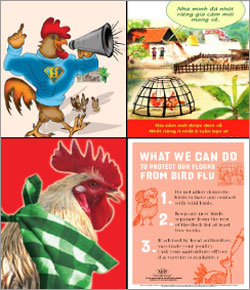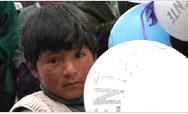USAID's Global and Regional Avian Influenza Activities
| |
 |
|
|
|
|
|
|
|
|
|
 |
| |
Materials used in USAID's avian influenza communications activities (prepared by the Academy for Educational Development). Clockwise from top left: Cambodia's "Super Chicken," Vietnam poster, educational poster, Ghana poster image. |
|
|
|
|
|
|
Updated September 2008
Since it first appeared in 1997, the highly pathogenic
H5N1 influenza virus has persisted as a significant threat
with the potential to trigger the next global influenza
pandemic. The United States Agency for International
Development (USAID), in close collaboration with the
Departments of State, Defense, Health and Human
Services, Agriculture, and Homeland Security, is a critical
partner in efforts to prevent this lethal virus from
spreading in animals and to reduce the possibility of it
also becoming a human contagion. Animal outbreaks
have been reported in 65 countries, and 15 countries
have confirmed a total of 387 human cases since 2003.
Of those cases, 63 percent have been fatal.
For updates, see the World Organization for Animal
Health and the World Health Organization Web sites.
The majority of animal and human cases have occurred
in Southeast Asia, and USAID, with its partners, has
concentrated a significant amount of resources in the
region. Early progress was reported in 2006 in a number
of the most affected countries in the region. Additional
work, however, is still needed in countries that have not
introduced an aggressive package of control measures.
A special effort is required in Africa, where poor health
infrastructure increases the potential for significant
mortality in the event of a pandemic.
To date, USAID has committed a total of $191,650,000 [PDF, 53KB] for avian influenza activities. Building on its humanitarian
assistance capabilities, USAID is also bringing special
attention to the need to prepare for a humanitarian
response should a pandemic occur. Detailed reviews of the three regions (Asia and the Near East [PDF, 236KB], Europe and Eurasia [PDF, 130KB], and Africa [PDF, 157KB]) that have received substantial funding for avian influenza are available.
|


